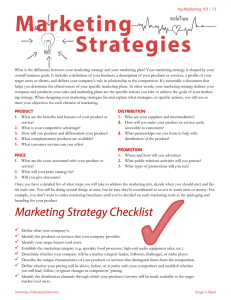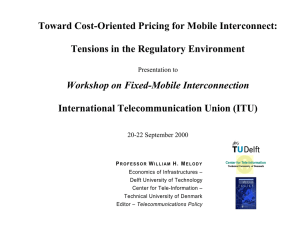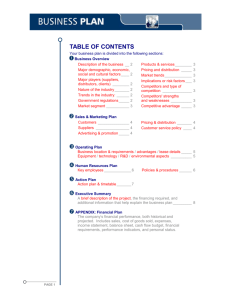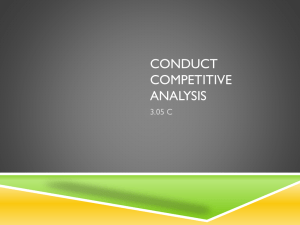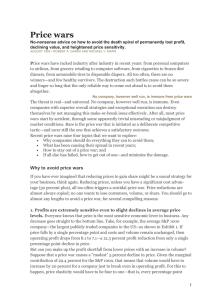HOW TO FIGHT A PRICE WAR
advertisement
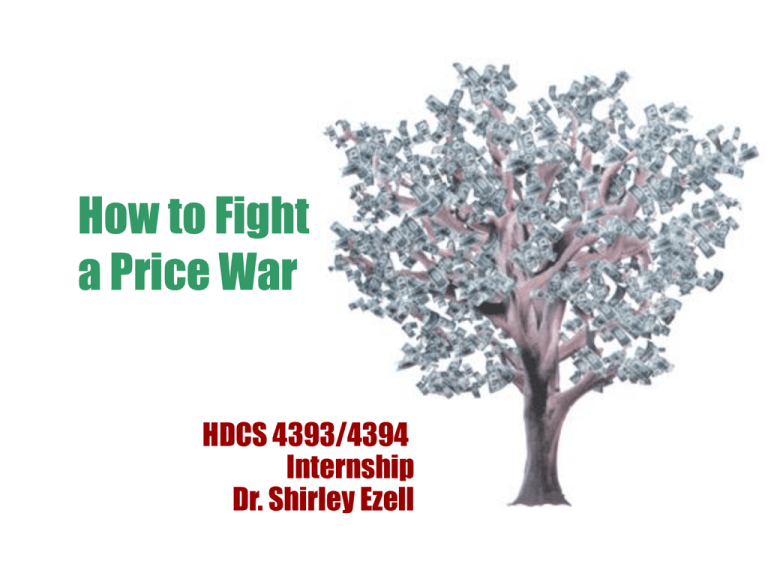
How to Fight a Price War HDCS 4393/4394 Internship Dr. Shirley Ezell Introduction Price wars are often described as the battle to win the customer. Creating low prices can degenerate into the loss of profit. Check out the airline story . Most managers will be in a price war during their careers. However, one should consider other options before starting a price war or responding. Learn alternative tactics. What are Alternative Tactics? A. Take Inventory: Price wars start because somebody thinks prices in a market are too high. B. Managers may view a price change as an easy,quick and reversible action. C. By understanding price war causes and characteristics, manager can make sensible decisions about when & how to fight one. First Step: Diagnosis Check out the case of the small commodities supplier. - What did he do? - What is the diagnosis? - What two things did the manager do? First Step: Diagnosis Intelligent analysis leading to accurate diagnosis emphasizes understanding the opportunities for pricing actions based on current market trends and responding to competitors’ resources. One looks to see why a prices war is occurring and where to look for resources to do battle. Stop the War Before it Starts There are several ways to stop a price war before it starts. Reveal your strategic intentions and capabilities: Offer to match competitors’ prices, offer everyday low pricing, or reveal your cost advantage. Compete on Quality: Increase your product differentiation by adding features or build greater awareness of existing features and benefits. Try to emphasize the performance tasks in low-priced options and co-opt contributors. Form strategic partnerships by offering exclusive deals with suppliers, resellers, or providers of related services. Check out the Sara Lee strategy. What Can We Learn from Other Companies? Check out the Winn-Dixie/ Big Star lessons. Ritz Carlton lessons. What are your Price Responses? Use complex price actions. How? Offer bundled prices: two-part pricing, quantity discounts, price promotions, or loyalty programs for products. Introduce new products: introduce brands that compete in customer segments that are being challenged by your competitors. Start simple price actions: adjust the product’s regular price in response to a competitors price change or another potential entry into the market. What else Should you Think about Before Joining a Price War? What do you know about your customers and their price sensitivity? Some consumers are more sensitive to quality than price. Some industrial buyers are willing to pay more for on-time delivery or consistent quality for their own profitability. Businesses that adopt a one-size-fits-all approach to pricing need to rethink this approach. What else Should you Think about Before Joining a Price War? (Cont.) Analyze your competitors’ cost structure, capabilities, and strategic positioning. Remember many unprofitable price wars happen because a company sees an opportunity to increase market share or profits through lower prices, only to find out that competitors will respond. You need to pay attention to who will respond and how. Use environmental scanning to identify company adversaries and their likely mode of operation. What do you Know about Contributors, Collaborators, and Other Interested Parties? A. You need to monitor other players in the industry who may affect price war outcomes (i.e. suppliers, distributors, providers of complementary goods and services, customers, government agencies). B. Contributors may help reduce price competition by enhancing the products’ value (see Intel examples). C. What can we learn from McDonalds’s,Taco Bell and 3M? What are the Lessons we can Learn? What can we expect during fighting it out and retreat? And what can we learn from it’s never too early to prepare?
